The Kibo Composable Commerce Platform (KCCP) supports several shipment types that represent different fulfillment methods, with a set of states for each step in that fulfillment process. In addition to those type-specific fulfillment states, there are a number of higher-level order statuses, additional shipment states, and statuses at the return, payment, and item level that provide detailed descriptions of where each element of an order is at on the way to completion.
This guide provides an overview of each fulfillment method supported by Kibo and the workflow for those shipments. For walkthroughs of processing shipments in the Fulfiller UI, see the corresponding guide for each fulfillment method.
Fulfillment Processes
Shipments are only available for fulfillment if their associated order is in particular payment rollup statuses. Unpaid or completely errored payments will block the order's shipments from being able to go through fulfillment. For more details about this behavior, see the Payment Object States section.
Additionally, STH, BOPIS, Delivery, and Transfer shipments must transition through all of the states listed in their workflows in order to be considered Completed. Changing the fulfillment flows are possible through the Kibo development team, which can configure new BPMs for custom states.
Ship to Home Fulfillment Process
Shipments can be shipped directly from fulfillers to the customer through the following BPM steps.
- Accept Shipment: The shipment has been created and is waiting to be accepted by the fulfiller that it has been assigned to.
- Validate Items in Stock: The shipment has been accepted and is ready to be picked either individually or as part of a pick wave before fulfillment.
- Print Packing Slip: The items have been picked and the packing slip is printed.
- Prepare for Shipment: The shipment has been packed and is ready to be shipped. The shipment is considered Complete when all information has been entered and the package is passed to a carrier. The only information that needs to be provided by the user is the package dimensions; Kibo will then retrieve the shipping label from the carrier and present it in the fulfiller interface to be printed.
- Complete: The shipment has been shipped.
This diagram illustrates the basic STH process flow, as well as showing how a split shipment occurs. There is not a true state for splitting a shipment, but it is important to understand where it occurs in the flow.
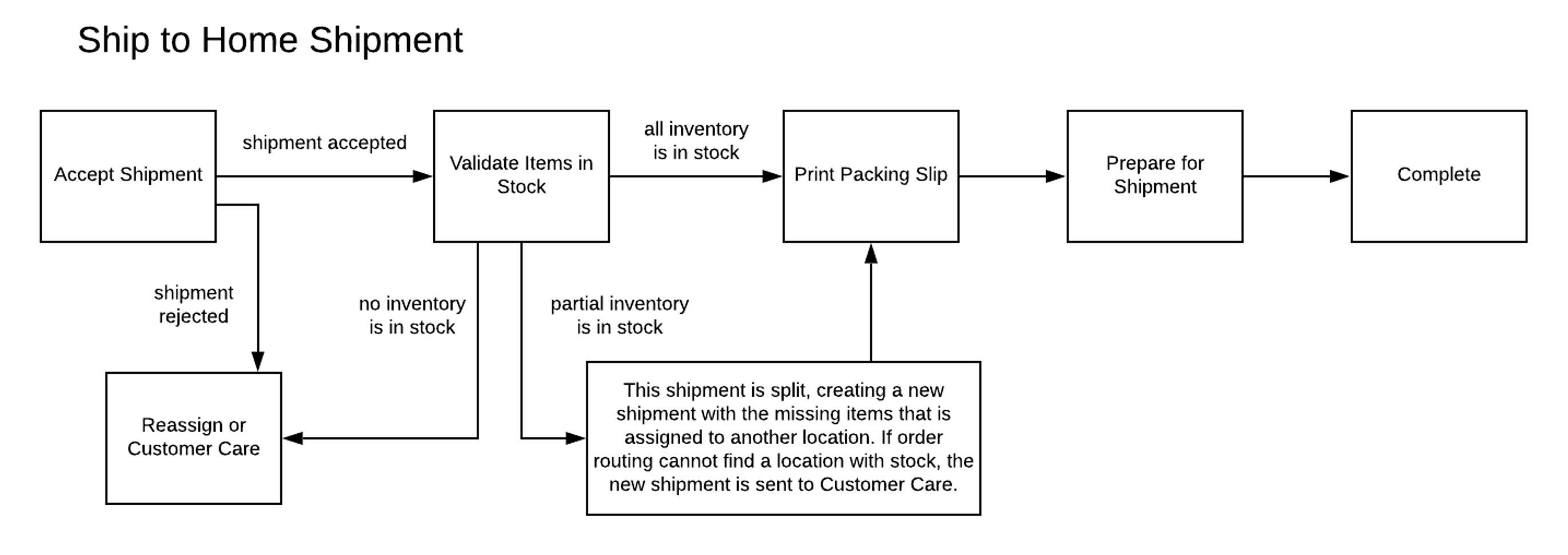
Ship to Home Consolidation
A variant of Ship to Home fulfillment is STH Consolidation. When enabled, STH shipments can use transfers to move all items to a centralized location to be shipped together instead of splitting the shipment. Fulfillers are able to save on shipping costs while improving the customer experience by allowing them to receive a single shipment instead of multiple.
When consolidation is triggered, the STH flow will include one additional transfer step:
- Waiting for Transfer: The shipment will go through this state if Order Routing determined that consolidation should be used during assignment. There may be more than one transfer shipment pending. All transfers must be received before the parent can continue to Prepare for Shipment.
The diagram below illustrates the altered STH flow that the parent shipment can go through when consolidation is enabled. By default, the fulfiller at the consolidation location must wait until all inventory is received before fulfilling any quantity. However, partial quantity can be fulfilled via API if some inventory is immediately available for fulfillment while other quantity is still waiting on transfer. See the Transfer Shipments guide for more information.
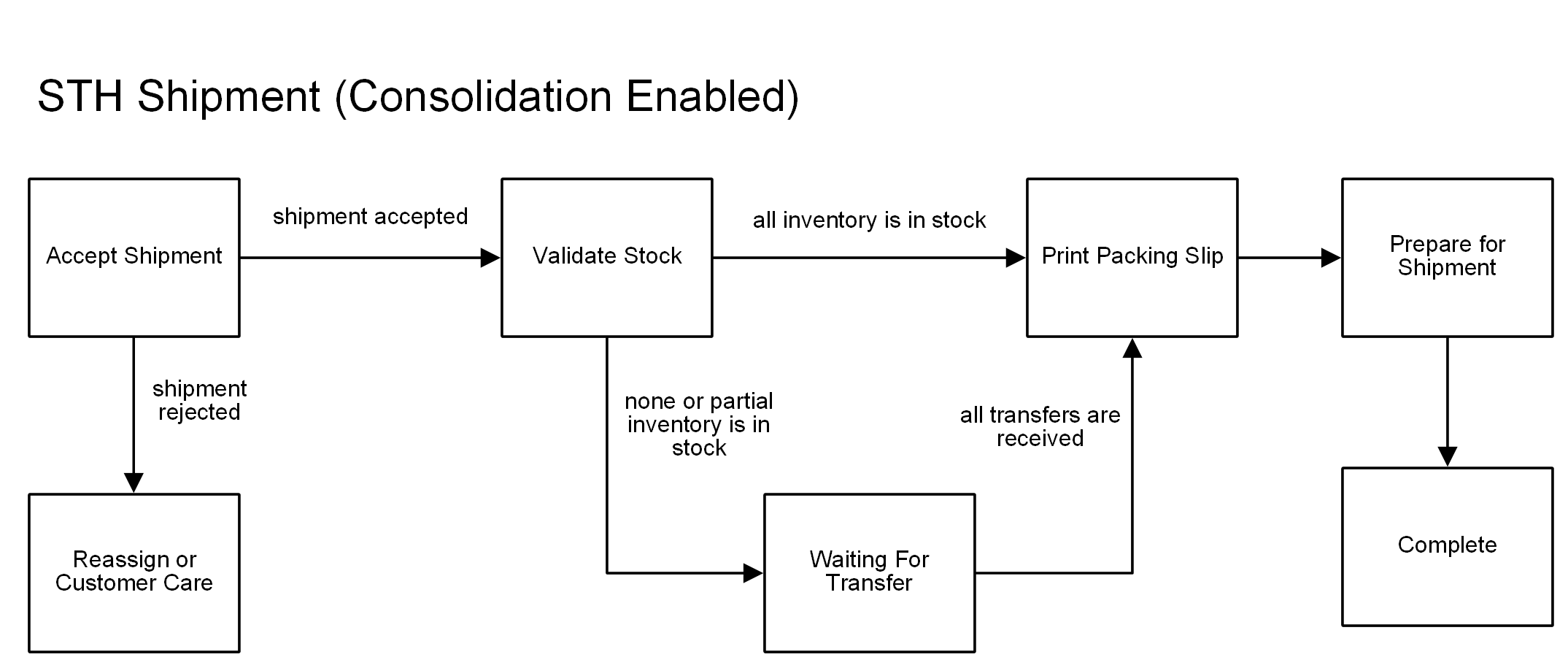
Buy Online Pickup In Store Fulfillment Process
Buy Online Pickup In Store, also known as BOPIS or “pickup,” involves the shipment being picked up at a store by the customer. In this case, the shipment goes through the following BPM steps.
- Accept Shipment: The order has been accepted and is ready to be sent through fulfillment.
- Print Pick Sheet: The pick sheet is generated for store associates to collect shipment items.
- Validate Items in Stock: The associate must confirm whether all items were available for picking.
- Wait for Transfer: The shipment goes through this optional state if inventory was not available and a transfer is requested. If inventory was not available but transfers are not enabled for the location, then the user must choose whether to cancel the item or send it to the Customer Care state (or backorder, if enabled).
- Customer Pickup: The shipment is ready to be picked up by the customer.
- Complete: The order is marked Complete once the customer collects it.
This diagram illustrates the basic pickup process flow, with options for whether a transfer is needed to supply missing inventory or not. For more details about partial pickup, see the Ship to Store Transfer guide.
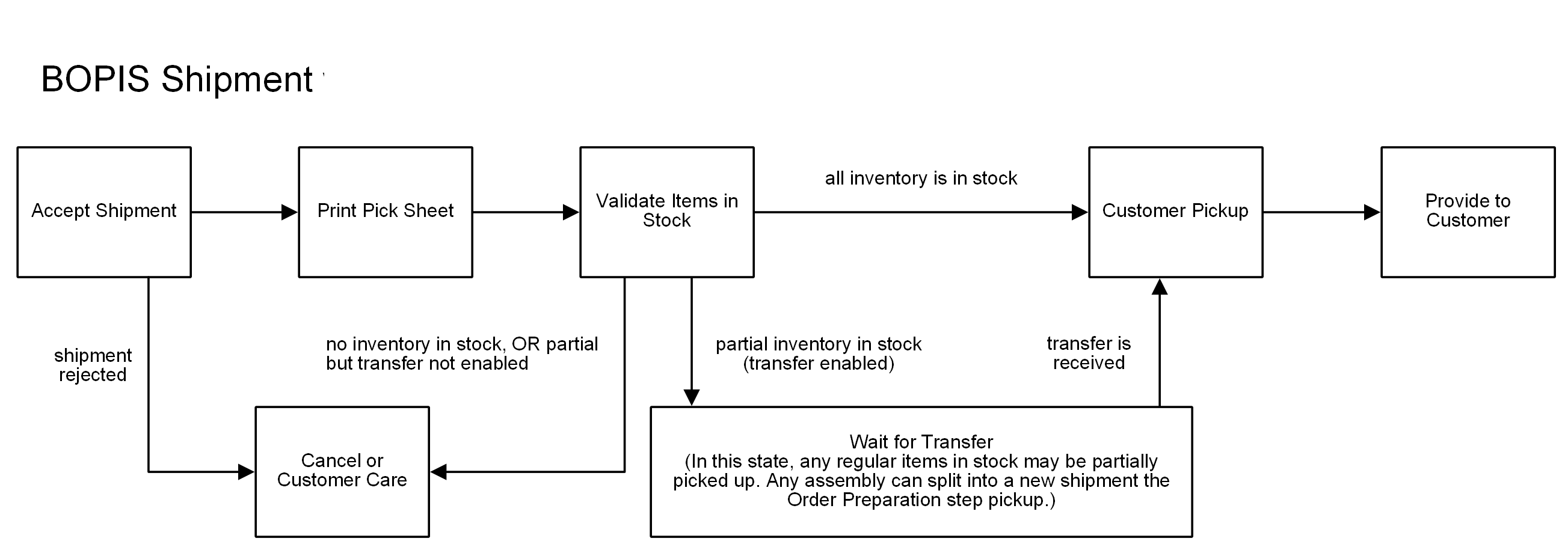
However, if a BOPIS shipment includes a service item (such as Assembly) then it will use an altered version of the usual BOPIS process with an Order Preparation step between Validate Stock and Customer Pickup. This step indicates that all items are at the fulfillment location and are being prepared prior to pickup.

Delivery Fulfillment Process
All items that require delivery, including those with assembly, will be grouped into a shipment of the Delivery fulfillment type. This fulfillment process includes a Delivery Preparation step (in which assembly is performed if an item on the shipment requires it), Dispatch, and Delivery Confirmation to fulfill the shipment via either the fulfiller's own trucks or a delivery provider.
- Accept Shipment: The order has been accepted and is ready to be sent through fulfillment.
- Print Pick Sheet: The pick sheet is generated for store associates to collect shipment items.
- Validate Items in Stock: The associate must confirm whether all items were available for picking. When the store indicates that the items have been picked then an email notification is sent to the customer informing them that the store will be calling to schedule a delivery date.
- Wait for Transfer: The shipment goes through this optional state if inventory was not available and a transfer is requested. If inventory was not available but transfers are not enabled for the location, then the user must choose whether to cancel the item or send it to the Customer Care state (or backorder, if enabled).
- Print Packing Slip: All items are at the fulfillment location and the packing slip is printed.
- Prepare for Delivery: All items are either being assembled or are ready for a delivery to be scheduled. The customer is charged for the order when the shipment enters this step.
- Dispatch: The items are ready to hand off to a delivery provider.
- Delivery Confirmation: The shipment is pending delivery confirmation from the provider.
- Complete: The shipment has been successfully delivered to the customer.
This diagram illustrates the basic delivery process flow, with options for whether a transfer is needed to supply missing inventory or consolidate shipments (which follows a similar process as that for STH Consolidation).

Transfer Shipment Process
Once a BOPIS or STH-Consolidation transfer is shipped, it must be received and validated by the final fulfillment location before it can be marked Complete. The parent shipment only moves on to the Customer Pickup state once all associated transfers have been received (in the case where multiple transfers were required).
- Validate Items in Stock: The associate must confirm whether all items are available in inventory.
- Print Packing Slip: If items are available, the packing slip can be printed to be added to the shipment.
- Prepare for Shipment: The items and packing slip are boxed and prepared for the carrier.
- Validate Incoming Transfer: The shipment has been sent to the final fulfillment location and is pending acceptance by that location.
- Complete: The transfer has been accepted by the location that requested it. This does not necessarily mean that the parent shipment is also Complete (picked up by the customer).
This diagram illustrates the states of the transfer shipment where it fits into the parent BOPIS and STH flows. For more details, see the Transfer Shipments guide.
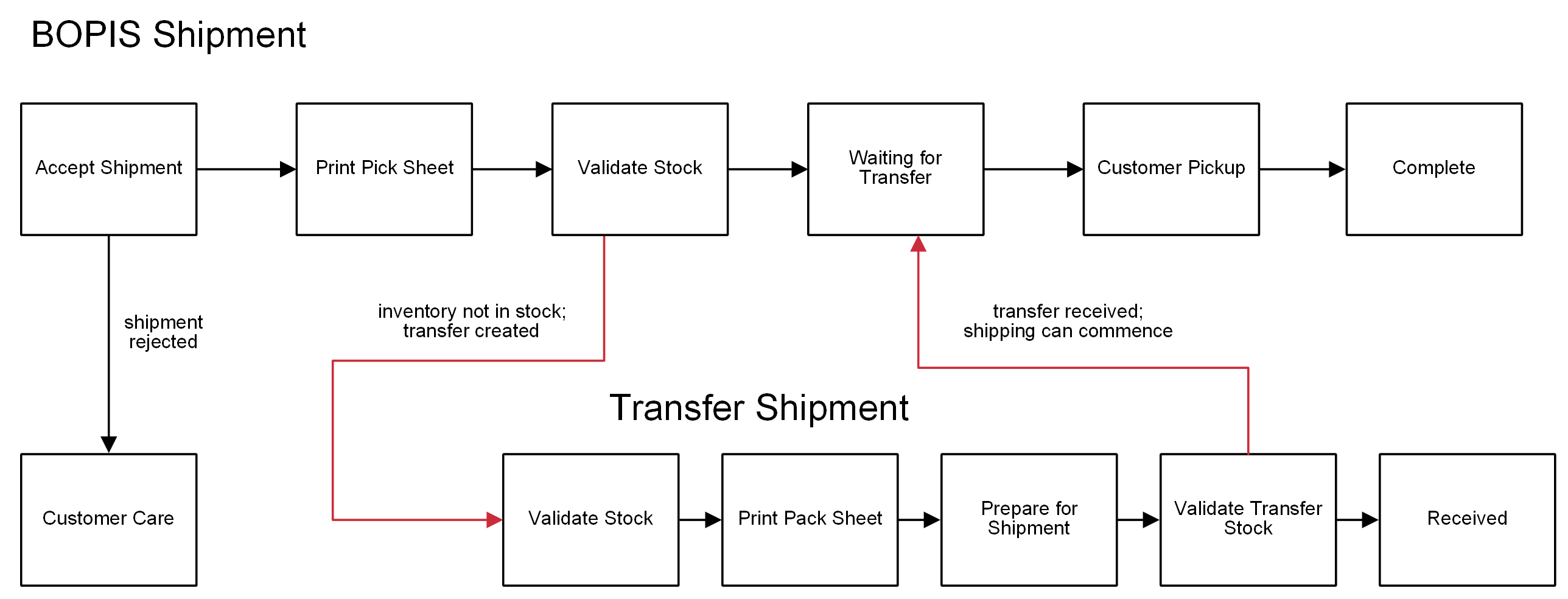

Curbside Delivery Fulfillment Process
The Curbside Delivery shipment process mirrors that of BOPIS as the steps to prepare a curbside delivery are the same as that of preparing a shipment for the customer to walk into the fulfillment location to collect. The “Customer Pickup” BOPIS step is renamed to “Provide to Customer” for Curbside, but all steps have the same function.
The Curbside Delivery business process manager steps are:
- Accept Shipment
- Print Pick Sheet
- Validate Items in Stock
- Wait for Transfer (Optional)
- Provide to Customer
- Complete
This diagram illustrates the basic curbside process flow:
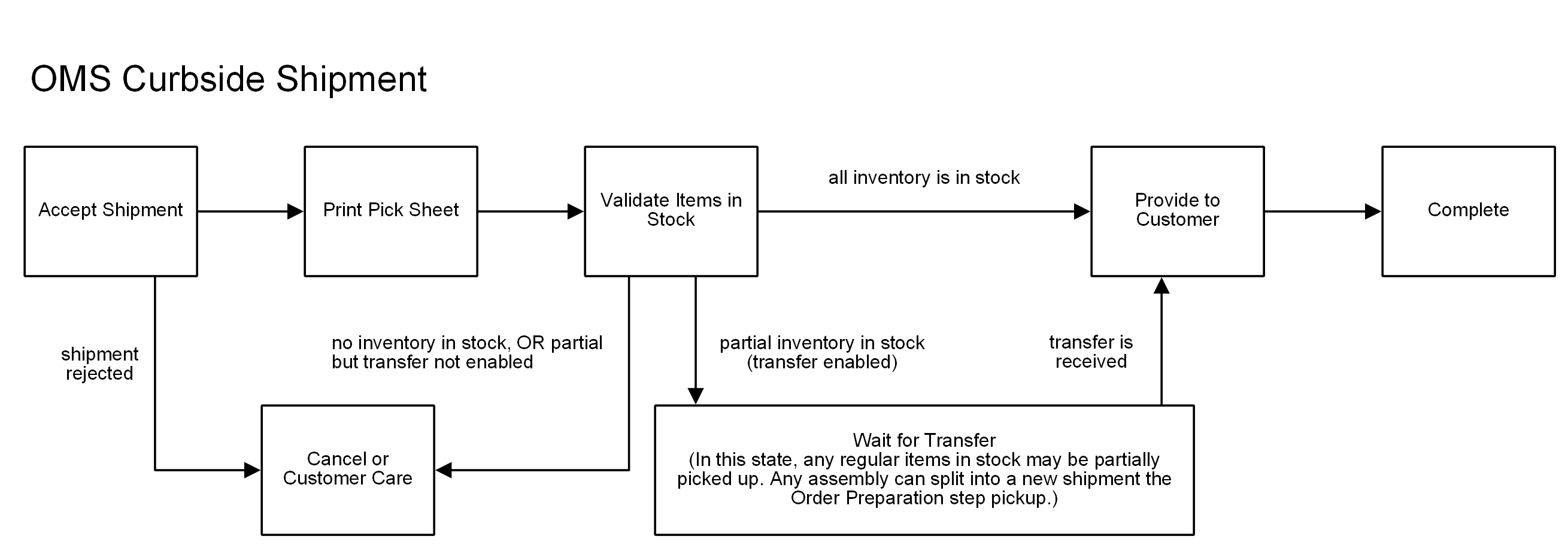
Digital Product Fulfillment Process
A digital fulfillment process allows orders to be placed for digital gift cards, store credit, and other digital items such as warranties or service fees. This does not include digital art, books, music, printable documents, or software that would require attachments or download links to be provided to the customer for fulfillment.
Digital products are indicated by product type settings that determine the goods type of the item. They are passed in with the shipment type or fulfillment method set to "Digital" in the API data, and then placed into a shipment that only consists of digital items. These shipments are automatically fulfilled when their order is Accepted and do not require any fulfiller behavior, as their information is emailed to the customer upon order creation (using the "Digital Item Fulfilled" email in your general settings). If this confirmation email fails, it can be resent from the Admin UI.
Payment on digital products is captured as soon as this fulfillment occurs, and does not wait for auto capture to kick in so that the shopper can receive their digital product email immediately. If this initial payment capture fails, then auto capture will catch it the next time it runs.
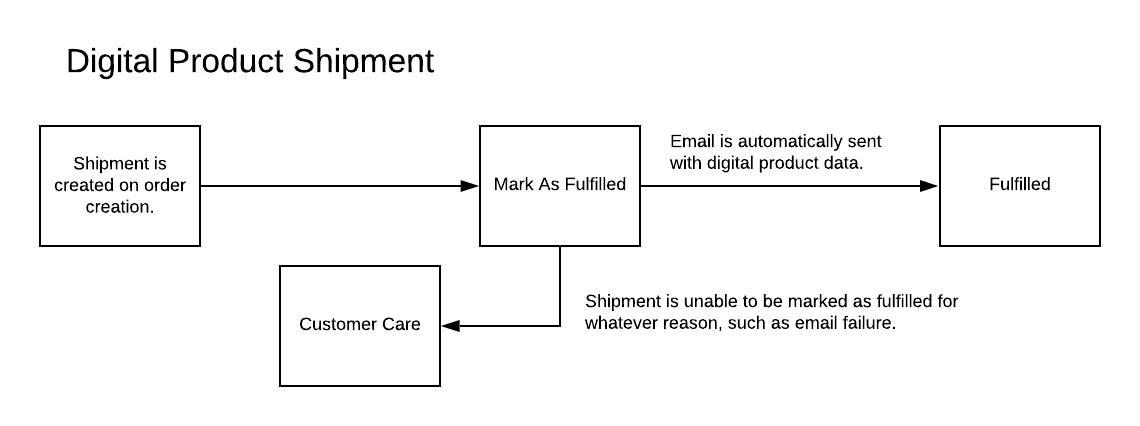
Backorder
When a shipment is backordered, it means that at least one shipment item is not available for fulfillment but can be ordered now for fulfillment at a later date. The interface will display the backordered status and available date (if known) of the item, both on the details view of an existing order and while adding an item to a new offline order.
Once inventory is available, it is allocated to the oldest order first and the shipment can be routed. In an implementation that utilizes both the Order Management and eCommerce solutions, the shopper is alerted while submitting an order if an item went into backorder during the final inventory check. The shopper is navigated back to checkout so they can remove the item if desired or continue submitting the order with the backordered item.
For more information about how backordered shipments are released, see the Backorder Release documentation.








